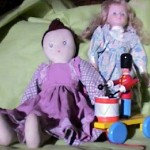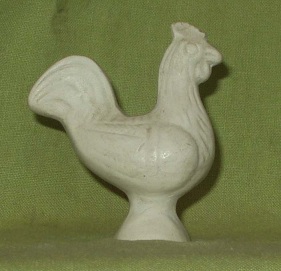“All work and no play makes Jack a dull boy”
Before compulsory schooling, children were expected to help their parents with all the chores associated with earning a living and keeping house. There was still time for children to indulge in a range of leisure activities, many of which remained unchanged for centuries. The most comprehensive record that survives of these pastimes is a C16th painting by Brueghel, entitled Children’s Games or Young People at Play. About 80 activities have been identified. Details of most of these, and how to play them, are available on http://www.gamesmuseum.uwaterloo.ca/VirtualExhibits/Brueghel/imgmap.html.
Hands-on Fun!
While Rent a Peasant cannot offer quite such variety, this option, by itself, is particularly suitable for indoor venues and small events, or can form part of a larger Living History display. The toys can be either specific to a particular period of history or a full range from Roman wooden doll to early C20th clockwork tin toys. Audience participation is particularly welcomed.
 Most toys were made of wood and probably made in the family. The first plaything for a baby would be a rattle. Spinning tops and whipping tops were invented centuries ago. Whipping tops and the diabolo require quite a knack, perhaps Grandad can remember! Cup and ball needs steady hand and eye. Girls have played with rag dolls and dolls with jointed limbs from the days of the Greeks and Romans, while the Victorians invented the china doll. Boys may prefer model animals, known from the earliest times, and the Noah’s Ark, drumming soldier and pop gun of the Victorian nursery.
Most toys were made of wood and probably made in the family. The first plaything for a baby would be a rattle. Spinning tops and whipping tops were invented centuries ago. Whipping tops and the diabolo require quite a knack, perhaps Grandad can remember! Cup and ball needs steady hand and eye. Girls have played with rag dolls and dolls with jointed limbs from the days of the Greeks and Romans, while the Victorians invented the china doll. Boys may prefer model animals, known from the earliest times, and the Noah’s Ark, drumming soldier and pop gun of the Victorian nursery.
 Sadly, modern legislation means that children are not allowed to try the C20th Tin Toys, but we are happy to demonstrate them. Small groups can try a game of strategy, such as 9 Men’s Morris, or the Roman dice game, Iactus. Larger groups can try playing Hunt the Thimble or Spinning the Platter.
Sadly, modern legislation means that children are not allowed to try the C20th Tin Toys, but we are happy to demonstrate them. Small groups can try a game of strategy, such as 9 Men’s Morris, or the Roman dice game, Iactus. Larger groups can try playing Hunt the Thimble or Spinning the Platter.
[cryout-multi][cryout-column width=”1/2″]
[/cryout-column] [cryout-column width=”1/2″]
[/cryout-column] [/cryout-multi]
[cryout-multi][cryout-column width=”1/2″]
[/cryout-column] [cryout-column width=”1/2″]
[/cryout-column][/cryout-multi]
Cock Shy
The cock shy was, by modern standards, a barbaric sport particularly associated with Shrove Tuesday, at the beginning of Lent. The bird was either tethered or buried up to its neck. The tethered bird had cudgels thrown at it by the participants, while the buried bird had blindfolded players taking turns to try and hit it with a flail. The person who killed the bird won it for dinner on the last day when meat could be eaten before Lent. The bird’s owner could make money from the game by charging for each throw at the bird.
Toy cockerels made of pottery are found on archaeological sites from Roman times. These toys suggest that children may have played a similar game, though more gentle or the toy birds would have broken. Wooden birds may have been more common and would survive rougher play.
By the 18th century, toy cock shies were made of lead alloy (Forsyth & Egan 2005, 238-241), so could survive being hit by harder missiles, in practice for the adult sport.
The shy using a live bird persisted into the 19th century but without the Shrove Tuesday association. Instead the gambling and money raising aspect appears to have been the motivation. An example from Tow Law in 1866 saw a variant of the cock shy called “holing the duck”. A pitman received a penny a stick for participants to throw at a drake buried up to its neck, the prize being the drake for the person who killed it. This case resulted in a successful prosecution for animal cruelty, though the defendant argued that the sport was common practice at Newcastle and other races.
[cryout-multi][cryout-column width=”1/2″]

The Rent a Peasant version of the children’s toy cock shy, with an unfired clay cockerel that can be broken to “kill” it and home-made felt balls to throw at the clay bird. This is a new addition to the activities offered by Rent a Peasant and is already proving popular with boys.
[/cryout-column] [cryout-column width=”1/2″]

The Rent a Peasant collection of toy ducks. As the example of “holing the duck” from Tow Law shows, drakes were used as well as cockerels for the shy. The Rent a Peasant toy ducks include wooden examples. A variant of the children’s game could be floating the wooden duck on water then skimming stones at it.
[/cryout-column] [/cryout-multi]
[cryout-multi][cryout-column width=”1/2″]
[/cryout-column] [cryout-column width=”1/2″]
[/cryout-column] [/cryout-multi]
Sources
H. Forsyth & G. Egan 2005. Toys, Trifles & Trinkets: base-metal miniatures from London 1200-1800
R. Hutton 1996. The Stations of the Sun
Tow Law: The First 150 Years. Local History booklet, 1994.






